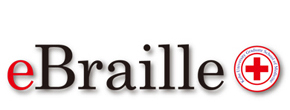 Since 1997 |
漢字仮名交じり文を点字に自動翻訳できる |
|
gateio eBraille for CBWA 医Braille (Ver. 2.00) 医Braille for CBWA eBraille (Ver. 1.61) 医Braille (Ver. 1.88) 東eBraille (Ver. 1.03) 英eBraille (Ver. 2.0) eBraille for tmacs |
|||
| ・eBrailleに関する学会発表('07) |_日本看護管理学会(8.24-25, 高知市) |_日本病院管理学会(10.25-26, 横浜市) |_日本医療情報学会(11.23-25, 神戸市) |_福祉情報工学研究会(12.5-6, 江東区) ・eBrailleに関する学会発表('08) |_自然言語処理研究会(3.27-28, 相楽郡) ・eBrailleに関する学会発表('09) |_教育工学研究会(3.7, 高松市) |_福祉情報工学研究会(3.23-25, 松江市) |_日本看護管理学会(8.21-22, 浜松市) ・eBrailleに関する学会発表('10) |_言語処理学会(3.8-11, 文京区) |_福祉情報工学研究会(3.12, 武蔵野市) |_福祉情報工学研究会(5.21, 新潟市) |_日本医療情報学会(11.19-21, 浜松市) |_SCOPE市民公開講座(12.10, 神戸市) |_HCGシンポジウム(12.15-17, 宮崎市) ・eBrailleに関する学会発表('11) |_福祉情報工学研究会(2.18-19, 松山市) |_福祉情報工学研究会 (5.22, 新潟市) |_日本医療情報学会看護学術大会 (7.17, 神戸市) |_国際医療情報学生物医工学会 (10.26-28, Bali) |_日本医療情報学会(11.21-23, 鹿児島市) |_SCOPE市民公開講座(12.17, 神戸市) ・eBrailleに関する学会発表('12) |_医療情報学連合大会(11.15-17, 新潟市) ・eBrailleに関する学会発表('13) |_福祉情報工学研究会(3.11-12, 福岡市) |_ ( ) |
|||
|
eBrailleに関する報道 その他のプログラム: ・音声補助付き触読点字e-learning ・触読点字e-learning ・点字e-learning ・eBraille (Ver. 0.91) Link: ・神戸大学大学院医学研究科 *他の点訳プログラム: ・当研究室はゲノム情報を扱い、分子細胞生物学実験とコンピュータシミュレーションの手法で研究を遂行しています。eBrailleの研究は、自然言語処理などの計算機による言語学の手法を、生命情報科学の解析手法に応用したいとの考えから、取り組みを開始しました。 |
|||
|
Japanese-into-Braille Translating Server
2007年4月から科学研究費補助金の交付を受けて、「バリアフリー実現は情報格差の是正から」を合言葉に、研究開発を推進しています。元々、eBrailleは1997年に東京大学医科学研究所ヒトゲノム解析センターの大学院生だった高岡(現・医療情報学分野 准教授)らが開発した、自動点訳ソフトです(Ver. 0.81)。このeBraille 0.81系の現バージョンはVer. 0.91であり、形態素解析に奈良先端科学技術大学院大学・松本研開発の「茶筌1.51」を利用したシステムです。 2007年4月から開発進行中のeBraille 1.61は、「茶筌 2.3.3」または「MeCab 0.996」と医療情報学分野で新開発した点訳エンジン「KUIC(クイック)」(Kobe University Intelligent eBraille Engine for ChaSen)の組み合わせにより日本点字表記法2001年版にほぼ準拠し、高い点訳精度と点訳速度を実現しました。また、これまでの点字GIFイメージによる表示に加えて、BASE形式(点字エディタの標準フォーマット)での出力も可能にしました。なお、eBrailleの点訳精度は再開発の結果2.2倍以上向上しており、トップクラスの点訳精度を実現しています。 我々はeBrailleの開発や医療応用に興味ある大学院生も募集中です。 ・eBrailleの研究開発目標として、医療現場での利用に耐える正確な自動点訳の実現に重点を置いています。これまで、神戸大学病院看護部の大島前部長と医療情報部の高岡准教授の共同研究として、両部門で取り組んできました。現在、松浦看護部長(副病院長)と高岡准教授の共同研究として取り組んでいます。看護部では院内バリアフリーに向けた取り組みとして、医療情報学分野では医療情報の自然言語処理としての取り組みが行われています。なお、この研究には茶筌とMeCabを開発しておられる、奈良先端科学技術大学院大学情報科学研究科の松本裕治教授の協力も頂いております。茶筌とMeCabを開発されている、松本先生と松本研究室の皆様に感謝いたします。
|
Development of a Japanese-into-Braille Translating Server
for the Internet (1998)Background Information
The Braille system, which was invented by Louis Braille in 1825 when he was only 15 years old and improved by him in 1837, is a universally accepted system of writing and reading used by and for people with impaired vision. However, unfortunately, there are not sufficient publications in Japanese for visually impaired people. We think the reason is that it requires a considerable number of people to translate ordinary books into Braille, although there are not enough volunteers to do the translating. Therefore, we have been trying to improve the efficiency of translating the conventional Japanese writing system into Braille with the help of a computer.The Characteristics of Our System
Taking into consideration the effective use of a computer, we have developed a Braille translating server using the server/client model based on the Internet technology with TCP/IP. Needless to say, this system on the Internet is a pilot version which is open to the public and can be accessed through any WWW browser for free regardless of the operating system of each user's computer. In this system, Braille is expressed in GIF images.Conclusion
We have succeeded in developing a simple but effective system which can translate Japanese into Braille and to which any computer user can gain access by WWW browser. We are now in the middle of developing a server which can not only translate Japanese into Braille editor format but also send the translation back to each user on an automatic basis.eBraille Ver. 0.81
Introduction of eBraille system

